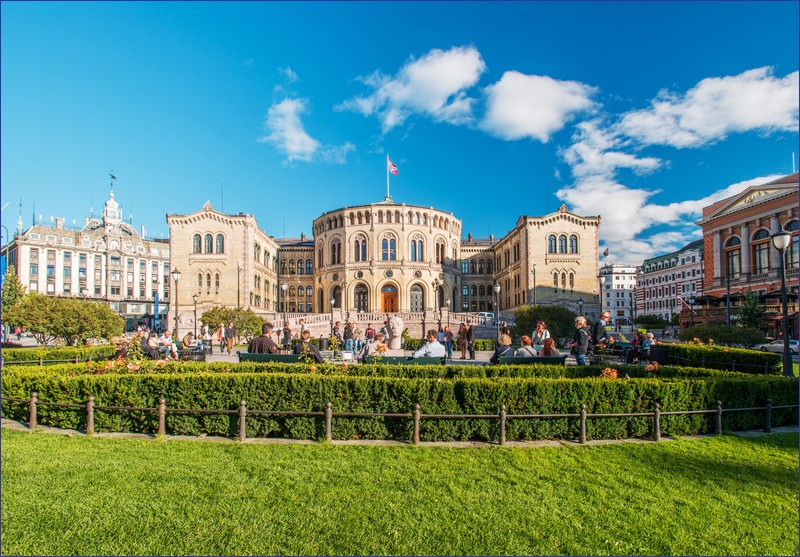Oslo is the oldest capital in Scandinavia. It was founded in 1048 by Harald III Hardrada, though settlements in the area of the present-day city existed as early as the 9th century. In the second half of the 11th century, a bishopric was established in Oslo, and a cathedral was built. At that time, however, the capital was Bergen.
Around the year 1300, Håkon V Magnusson moved the capital to Oslo, sparking the city’s dynamic development. In 1349, the Black Death decimated the population, and in 1624, a massive fire destroyed the city.
Following the fire, the Danish king Christian IV ordered the city to be relocated closer to the Akershus Fortress and renamed it Christiania. After Denmark ceded Norway to Sweden, Christiania developed rapidly. In 1905, it became the capital of independent Norway. After a referendum in 1925, the name was changed back to Oslo.
Today, Oslo is a bustling city with a population of over 500,000. While it has relatively few historical landmarks open to visitors, the city is famous for its rich museum offerings.
Major Landmarks and Attractions
The Royal Palace (Norwegian: Det Kongelige Slott) – the official residence of the Norwegian monarchs, located on a small hill at the end of the city’s main street. The Royal Palace was built between 1828 and 1848. The palace interiors are open for guided tours during the summer season, while the surrounding palace park is accessible year-round. Every day at 1:30 PM, the changing of the guard takes place in front of the palace. Near Karl Johans Gate, you can also find other notable buildings such as the Parliament and the National Theatre. The Parliament can be visited with a guide during the summer at designated times.
Akershus Fortress (Norwegian: Akershus Festning) – a fortified area built by order of Håkon V Magnusson in the early 14th century after the capital was moved to Oslo. Over the centuries, the fortress underwent multiple renovations and is now a popular area for walks and leisure. Within the walled grounds are several significant tourist attractions.
Akershus Castle (Norwegian: Akershus Slott) was built in the mid-14th century. After renovations in the 16th century, it was transformed into a royal residence. Visitors can tour elegant halls, the royal mausoleum, a historical exhibition, and a church dating back to 1580.
Within the Akershus Fortress area, you can also visit the Norwegian Resistance Museum (Norwegian: Norges Hjemmefrontmuseum), which covers the World War II resistance movement, and the Armed Forces Museum (Norwegian: Forsvarsmuseet), with a permanent exhibition showcasing the country’s military history from the Middle Ages to World War II. It’s also worth seeing the Christiania City Model (Norwegian: Christiania Bymodell), a scale model of the city as it was between 1624 and 1680.
Oslo Opera House – This modern opera building, located near the main train station (Oslo Sentralstasjon), has won numerous awards in prestigious architectural competitions. Visitors can walk freely on the opera’s rooftop year-round. It is one of the most popular spots in the Norwegian capital, and souvenir photos taken on the roof frequently appear on social media.
Oslo City Hall (Oslo Rådhus) – Designed in the late 1920s and early 1930s and completed after World War II, this building evokes strong opinions from both residents and tourists. The massive brick structure, topped with two towers over 60 meters high, stands on the waterfront and is visible from almost anywhere in the capital. Each year, the Nobel Peace Prize ceremony is held in its grand hall. Inside, visitors can see an exhibition about the history of the Peace Prize, a museum room with art displays, and the richly decorated main hall, which is particularly striking. Guided tours of the City Hall are available at times announced on the official Visit Oslo website.
Aker Brygge – A modern waterfront district home to the most expensive apartments in Norway. Developed in the late 20th century, it quickly became a tourist attraction thanks to its numerous cafés and pleasant atmosphere. A walk along the promenade is a must-do while visiting Oslo. Aker Brygge is connected by a bridge to the neighboring district of Tjuvholmen, known as the art district. In addition to cafés and restaurants, Tjuvholmen features various art installations and galleries.
Vigeland Park – The largest park in Oslo, open to the public free of charge all year round. It is best known for the sculptures by Gustav Vigeland. The park features 212 sculptures depicting over 600 figures, most of which are placed along the main avenue that cuts through the park.
Holmenkollen Ski Jump – Fans of ski jumping and winter sports should plan a visit to the Holmenkollen Ski Jump. The first Holmenkollen ski jump was built in 1892. In 2008, the old jump was demolished and replaced with a new ski jump, which opened in 2010. Next to the jump is the Ski Museum, and visitors can also take an elevator to the observation deck at the top of the structure. The ski jump is located amidst picturesque forests and ski areas. Nearby, you can also see the wooden Holmenkollen Chapel and a Troll statue. The best way to reach the ski jump from the city center is by taking metro line 1 toward Frognerseteren.
Norwegian Museum of Science and Technology (Norwegian: Norsk Teknisk Museum) – An engaging museum dedicated to the development of industry and technology in what is now Norway. Currently, the museum offers 25 permanent exhibitions on a wide range of topics. Visitors can explore exhibits covering areas such as the timber industry, oil and gas, transportation, metallurgy, aviation, medicine, and clocks and watches.
Related articles:
Train travel in Norway – a comprehensive guide
